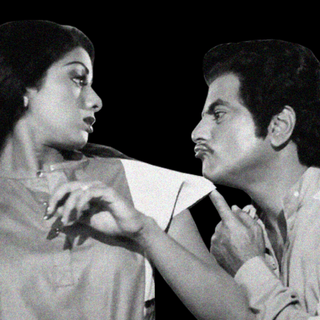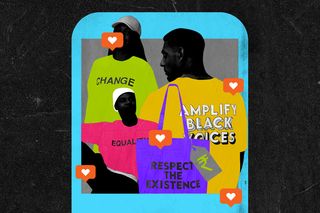
Why Retailers Rebranding as ‘Woke’ Is Disingenuous
Netflix’s ‘White Hot’ traces the story of Abercrombie & Fitch, but inadvertently prompts questions of whether retailers rebranding through inclusivity is enough.

“White Hot: The Rise and Fall of Abercrombie and Fitch” is a Netflix documentary that ends on a hopeful note. “Exclusion itself stopped being cool,” says one former A&F rep. It became a “place of belonging” rather than “fitting in,” as per the new CEO’s vision. These quaint declarations set to an uplifting background score are followed by visuals of what A&F is now, supposedly to show how far they’ve come. An Instagram post showcases the “For Justice Collection” that, according to the post’s caption, is “designed by A&F BIPOC associates” and “calls for racial justice.” A model poses in a plain white tee, with “Equality” written in the front and “For Justice For Peace” emblazoned across the back.
The CEO, the documentary will have us know, is focused on “listening to customers.”
When a company is no longer “what they used to be,” it’s not because they grew a conscience; it’s because it’s no longer profitable to be that way. Instead, we are in an age where it is profitable to be what they vehemently claim they are now: diverse, inclusive, and woke. It is merely smart business sense to look, sound, and act woke – inclusivity, rather than exclusivity, now sells the most. However, the fact that it is this easy for white supremacist, diet-culture enabling retailers like A&F to rebrand should give us pause. How did this happen? Is this what we asked for?
It has to do with the fact that brands have always had an eye on youth culture. Once, brands told the youth how to be; now, youth culture tells them how to be. Where the old guard had its eye on aspirational youth culture, the new epoch of marketing dictates that brands look at what youth culture is and emulate it. But a closer look shows how it appears to emulate it while still keeping it tantalizing yet unattainable.
A&F is an example of a brand that got everything right, until it got it all wrong: it sold a dream, an ideal of American beauty rooted in racist exclusion of who has access to that beauty. Its emphasis on the “All-American” (almost a Nazi-esque “Aryan”) look reinforced the notion that to be All-American and beautiful was to be white, thin (or ripped, if you were a guy), with a rugged sexiness that is effortless if you already fall into the first two categories. The brand explicitly walked their talk: their clothes were not meant for everyone. In the 2010s, things began to shift: the rise of a generation born and raised on social media meant that the brand’s target demographic shifted base right under their noses, without them realizing it.
Related on The Swaddle:
Lifestyle Brands Are Showcasing Their Humanitarianism, Blending Activism and Retail
As a result, A&F missed the memo on what youth culture really is all about today: being woke. Even though A&F was late to the party, they hopped onto a bandwagon that already contained other retailers who got there ahead of them. Robin Givhan, a critic at the Washington Post, notes in the documentary how fashion was notorious for never doing any market research. But with social media, this has changed forever: Instagram is the market research. They offer a peek into what young people are doing and saying more than ever before. And what we are doing and saying, more often than not, is resisting forms of oppression and exclusion. We’re saying: not anymore – and brands are listening, churning away in the background as to how to use this information for profit.
They’re also beginning to do actual market research. An analysis by McKinsey and Business of Fashion found that young consumers “increasingly back the beliefs with their shopping habits, favoring brands that are aligned with their values and avoid those that don’t.”
The catch, however, is that retailers simply use these ideals when they’re easy and popular. In fashion, particularly, convoluted global supply chains make it impossible to know how a particular garment was produced. Outrage over reports of Uyghur Muslims in Chinese detention camps being forced to produce cotton in supply chains connected to Calvin Klein, Ralph Lauren, and other major brands gave the companies pause – for a while. Before long, the parent companies of Zara, Calvin Klein, Vans, and others quietly removed company policies against forced labor from their websites in response.
That social media has become one of the main sites of protest, politics, and dissent for the youth makes it clear to brands that this is what will sell as long as they are seen to be doing the right thing. As a result, revolutionary slogans, symbols, and iconography have become cheapened; they are now a vibe more than they are political, because brands cater to a demand to always be wearing your beliefs on your sleeve.
Brands can thus continue to keep their outrageous markups, exploit garment workers in the global south, even retain the same ideals of beauty but simply fit different bodies within these ideals. In the process, they make diversity complicit in an exclusionary narrative. The diversity still comes with caveats: You don’t have to be white, but you still have to be statuesque with perfect hair, perfect skin, and an elegant, aquiline nose to look good in our clothes. You don’t have to be thin, but you still have to have a pretty face sitting on a body that’s sexy, inviting. You don’t have to be straight, but you do have to accessorize our products with piercings, tattoos, and some form of rainbow imagery in the background. If you are all of the above, still have all of the above.
When brands thus transition from what they were (white, exclusionary) into what they supposedly are (diverse, exclusionary), they maintain the aspect of retail branding that sold exclusionary ideas of beauty in the first place. It also paves the way, neatly, for the desire of more commodities to complete the aesthetic. You might want to invest in make-up that caters to your skin-tone, or buy hair care that makes your curly, wavy, kinky, resplendent with gloss and buoyancy. But always, buy many other things.
Related on The Swaddle:
Tell Me More: Talking Inequality in Sustainable Fashion Aesthetics With Meher Varma
And sure, you can look at diverse models wearing what only white and thin people used to wear – but can youafford it? By making social justice cool, brands then create a psychological process of coveting the cool thing by dangling it at a distance that is not quite out of reach, because of what you see, but almost out of reach because of the same pricing regime that sets all “cool” brands apart.
In making us fetishize this aesthetic, brands turn social justice ideas into commodities. It used to be that sex sells; now, it is social justice that sells. Just like how sex became aestheticized and detached from the actual phenomenon itself, social justice too has left the confines of earnest, honest political dialogue and entered the domain of commerce. Where radical ideas once existed on pamphlets, they are now metaphorically on graphic tees. And they cater to a sense of moral self-indulgence among the woke youth privileged enough to buy these products, giving a nod to the woke CEOs that their tactics are workiy.
In a way, it tells us something unpleasant about ourselves: we, too, like to be seen saying and doing the right things, without sacrificing an aesthetic built on an exclusionary foundation.
The branding “reinforces the identity of the privileged consumer. The upper middle-class shopper of goods can now not only look good but also feel good, as digitized activism and shopping seamlessly come together,” wrote Meher Varma for The Swaddle.
The fatal flaw, it would seem, is mediating social justice through social media. The real estate that former occupies in the latter also implicitly cements its relationship with money: since social media is for-profit. Social justice slogans are urgent and captivating. They become a focal point for mobilizing many people – this, in fact, is the point. But when they are mobilized online, it becomes a tool for wily companies who share the same space to extract money. Unlike a physical protest site, social media is a space where rhetoric can be infiltrated by corporates in plainclothes, who then slap it on a t-shirt and sell it back to the people it came from. Platforms like Instagram are not inert spaces; they actively collaborate and collude with the corporates to boost their sales while simultaneously advancing the same language that they’ve seen hooks people.
“Sometimes, the lingo is so good that we forget that this generosity is mediated by retail… It is the algorithm of retail cool,” Varma continues.
When this happens, politics itself becomes shallow, superficial. It’s more about declaring that you’re decent in thought, without needing to follow-up on it with action. By appropriating these ideas, brands implicitly sell the notion that to show who you are is the point of politics. And what you wear, consequently, is who you say you are.
It also has to do with what we demand of brands now. We often don’t call for an end to exploitation, only exclusivity. When they do something problematic, we demand that they “do better,” instead of calling for abolishing the mode of fashion and lifestyle that led to it in the first place.
You can now buy “sustainable” clothing in designs appropriated from marginalized communities for a marked-up price or buy a “feminist” tee made by an underpaid and overworked woman in Bangladesh. Either way, you lose and your beliefs lose, while brands win.
Rohitha Naraharisetty is a Senior Associate Editor at The Swaddle. She writes about the intersection of gender, caste, social movements, and pop culture. She can be found on Instagram at @rohitha_97 or on Twitter at @romimacaronii.
Related


It’s Okay: To Be Irrational
